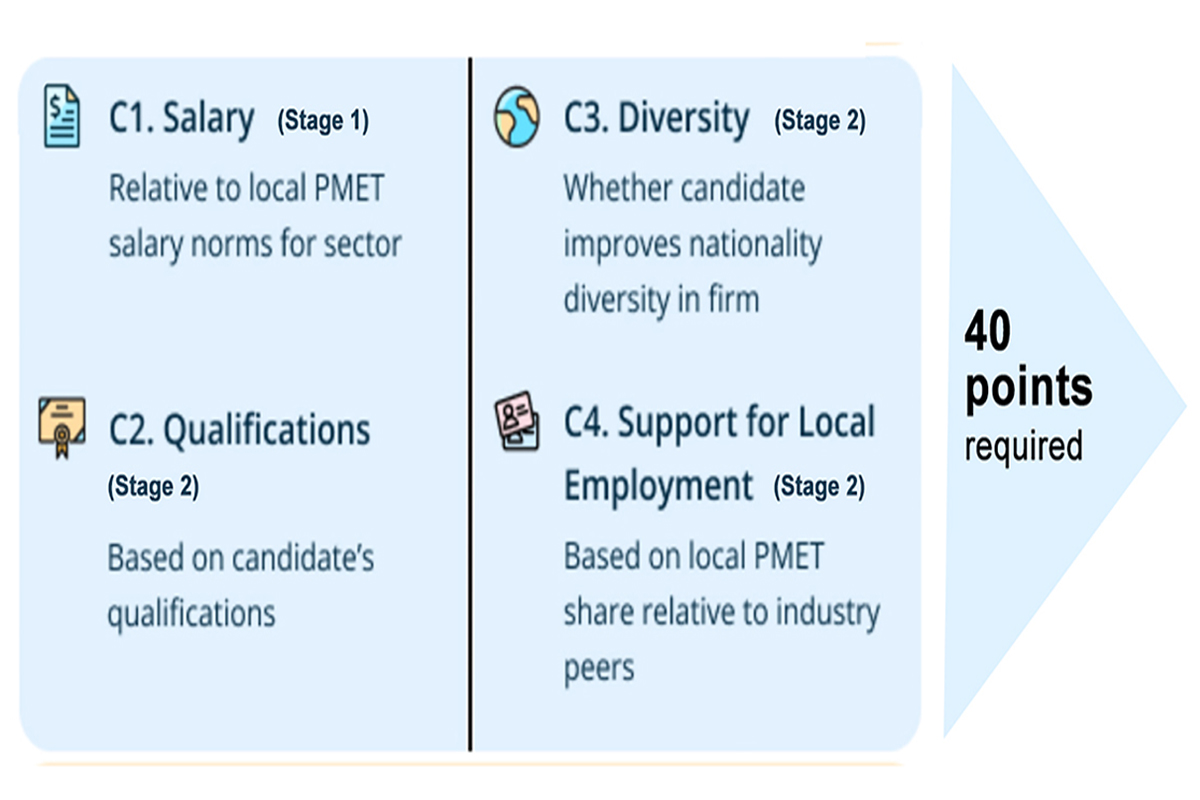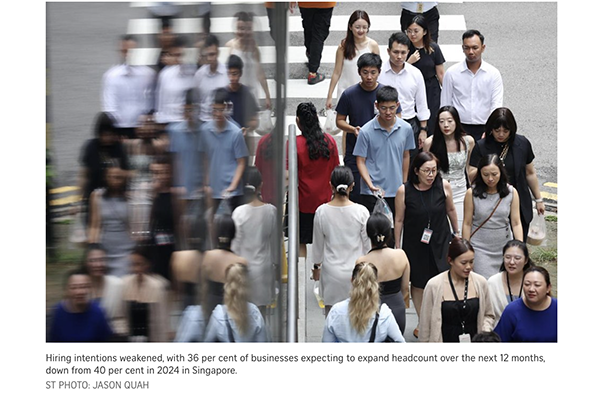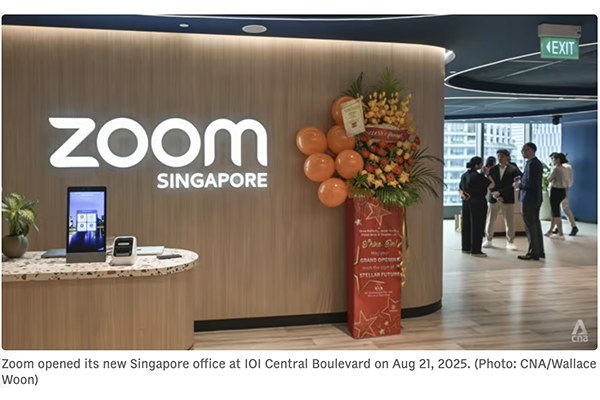1. Overview of the Work Permit (WP)
The Work Permit (WP) is a pass issued by Singapore’s Ministry of Manpower (MOM) that allows semi‑skilled migrant workers from approved source countries to work in the construction, manufacturing, marine shipyard, process and services sectors. Malaysian nationals are one of the approved source countries. Key features include:
Who can apply: Only the prospective employer or a licensed employment agency can submit application on behalf of the worker. The worker must be from an approved source country and will work only for the sponsoring employer and in the registered occupation.
Age and tenure: The minimum age is 18 years, and from 1 July 2025 all non‑domestic migrant workers (regardless of nationality) must be below 61 years old at the time of application. WP holders can work any number of years up to 63 years old—the previous limits on maximum employment period and differing age caps for Malaysians versus other nationalities have been removed.
Validity: WP validity can be up to two years, depending on the worker’s passport validity, security bond and the employer’s requested employment period. It is renewable if the worker remains eligible and the employer meets quota and levy requirements.
2. General obligations and processes
2.1 Pre‑employment & application
In‑Principle Approval (IPA) & declaration of business activity – before hiring, the employer must declare its business activity to be assigned to the appropriate sector. Upon approval of the WP application, MOM issues an In‑Principle Approval (IPA) letter allowing the worker to enter Singapore. The employer must arrange the worker’s arrival and register them for the necessary courses (e.g., Settling‑in Programme or safety courses if required).
Medical insurance & Primary Care Plan (PCP) – the employer must buy medical insurance for each WP holder. For workers staying in dormitories (≥7 workers) or who work in the Construction, Marine shipyard or Process (CMP) sectors, the employer must purchase a Primary Care Plan and declare it before the permit can be issued or renewed.
Security bond – employers must buy a S$5,000 security bond for every non‑Malaysian WP holder. Malaysians are exempt from the bond requirement. The bond is a pledge to pay the government if the employer or worker violates the Work Permit or bond conditions. The bond must be purchased before the worker arrives in Singapore and will be discharged only after the WP is cancelled and the worker has left Singapore.
Settling‑in Programme (SIP) – first‑time non‑Malaysian WP holders in the manufacturing, construction, marine shipyard or process sectors must attend a one‑day Settling‑in Programme to learn about employment laws and living in Singapore. Malaysians are exempt from the SIP.
Required safety courses – sector‑specific safety courses (e.g., Metalworking Safety, Shipyard Safety Instruction) must be completed before a WP is issued; workers have to pass them within a few months of arrival or the WP may be revoked.
2.2 During employment
Foreign worker levy payment – employers must pay a monthly levy for every WP holder. The levy is due by the 17th of the following month; late payment results in penalties, revocation of work passes and a ban on applying or renewing new permits. Levy payments can be made via GIRO or PayNow.
Levy waiver – employers may apply to waive the levy in specific situations such as when a worker attends the Onboard programme, is on overseas leave or hospitalisation leave (capped at 60 days/year), is in police custody, has died, or when a Malaysian worker is serving national service. Applications must be made within one year of the levy bill and require supporting documents.
Salary & housing obligations – employers must pay the declared salary on time and provide acceptable housing (e.g., dormitories approved under regulatory standards). Employers must not illegally recover costs or take the worker’s passport. There is no minimum salary for WP holders; however, the Local Qualifying Salary (LQS) for local employees determines how many WP holders can be hired (see §3).
Medical & welfare obligations – besides medical insurance and the PCP, employers must send workers for the required medical examinations and maintain safe working conditions.
Employment restrictions – WP holders can work only for the employer and in the specified occupation. They cannot marry a Singapore citizen or permanent resident without approval and cannot become pregnant (unless married to a citizen/PR) (older policy). Changes in occupation or employer require a new application.
3. Local qualifying salary and quota (Dependency Ratio Ceiling)
3.1 Local Qualifying Salary (LQS)
To regulate the ratio of foreigners to locals, MOM counts the number of local employees who earn at least the Local Qualifying Salary (LQS). The LQS (updated in 2024) is S$1,600 per month; part‑timers must earn ≥S$10.50/hour. A local employee is counted as 1 if they earn ≥S$1,600 and 0.5 if they earn between S$800 and S$1,600. Employees earning <S$800 are not counted. Employers must pay CPF contributions and declare salaries accurately; under‑declaration reduces the quota and may result in higher levy tiers.
3.2 Dependency Ratio Ceiling (DRC) and quotas
Each sector has a Dependency Ratio Ceiling (DRC) – the maximum proportion of WP (and S Pass) holders relative to the total workforce. The current DRCs (updated to August 2025) are listed below:
| Sector | Maximum percentage of foreign workers (DRC) | Equivalent WP per local employee |
|---|---|---|
| Construction | 83.3 % | 5 WP per local |
| Process (petrochemical, pharmaceutical plants) | 83.3 % | 5 WP per local |
| Marine shipyard | 77.8 % | 3.5 WP per local |
| Manufacturing | 60 % | 1.5 WP per local |
| Services | 35 % | 0.538462 WP per local |
Companies must ensure their total number of WP holders does not exceed the DRC. For example, a services company cannot have WP + S Pass holders exceed 35 % of its workforce. If the DRC is breached, the firm cannot apply or renew passes above the limit and may have to reduce foreign workers.
So in practice:
To qualify 1 WP, you generally need 2 locals at full LQS OR 4 locals at half LQS in the services sector.
Other sectors (construction, manufacturing, process, marine shipyard) have different DRC percentages, so the ratio changes. For example:
Manufacturing: 60% DRC → 1 local can support 1 WP, but 2 locals can support 3 WPs.
Construction: up to 83.3% DRC → 1 local can support 5 WPs.
4. Levy rates and sector
4.1 Specific requirements for Malaysian workers
The levy is a monthly fee paid by employers for each WP holder. Levy rates vary by sector and whether the worker is basic‑skilled or higher‑skilled. Higher‑skilled status usually requires certain qualifications (e.g., Malaysia’s Sijil Pelajaran Malaysia (SPM) certificate, a fixed monthly salary and experience) and results in a lower levy. The following table summarises the levy rates (per month) for Malaysian workers as of August 2025. Daily levies apply when the worker does not work a full calendar month, calculated by (Monthly levy × 12)/365.
| Sector (DRC) | WP per local | Malaysian worker – higher‑skilled levy | Malaysian worker – basic‑skilled levy | Notes & additional conditions |
|---|---|---|---|---|
| Construction – DRC 83.3 % | 5 WP per local | S$300/month | S$700/month | Levy tiers apply regardless of total workforce (no separate tiering). At least 10 % of construction WP holders must be Higher‑Skilled (R1) before new basic‑skilled (R2) workers can be hired. Off‑site construction facilities enjoy lower levies (S$250/S$370). |
| Manufacturing – DRC 60 % | Not expressed as WP per local but limited to 60 % of workforce | Tier 1 (≤25 % of workforce): S$250; Tier 2 (25–50 %): S$350; Tier 3 (50–60 %): S$550 | Tier 1: S$370; Tier 2: S$470; Tier 3: S$650 | Firms can hire from Malaysia, PRC and NAS; NTS workers are allowed only in specific occupations. First‑time non‑Malaysian workers must attend SIP. |
| Services – DRC 35 % | Calculated via DRC | Tier 1 (≤10 % of workforce): S$300; Tier 2 (10–25 %): S$400; Tier 3 (25–35 %): S$600 | Tier 1: S$450; Tier 2: S$600; Tier 3: S$800 | Eligible occupations include hotel, retail, transport and food services. Non‑Malaysians may need Workforce Literacy/Numeracy (WPLN) tests. |
| Process – DRC 83.3 % | 5 WP per local | S$200/month | S$450/month | Levy rates for NTS workers are higher (S$300/S$650). Employers must be members of ASPRI and can only hire for process maintenance & construction occupations. |
| Marine shipyard – DRC 77.8 % | 3.5 WP per local | S$300/month | S$400/month | From 1 Jan 2026 the DRC will be reduced to 75 % (3 WP per local) and levies will rise to S$350 (higher‑skilled) and S$500 (basic‑skilled). |
Example Case: Mr. Tan (F&B Operator)
Mr. Tan operates a small F&B business and wants to hire a Malaysian worker under the Work Permit (WP) scheme.
- Meeting Local Headcount & CPF Contribution
- To qualify for 1 WP in the services sector, Mr. Tan must have at least 2 local employees earning the Local Qualifying Salary (LQS) of $1,600/month each.
- These locals must be registered in CPF contributions at or above this threshold.
- Hiring the First WP (Malaysian Candidate)
- With 2 locals ($1,600 CPF each), Mr. Tan hires 1 Malaysian WP.
- His Dependency Ratio (DRC) is now 1 foreigner out of 3 total staff = 33%, which is within the 35% service sector limit.
- If his Malaysian hire holds SPM qualifications, he can be classified as higher-skilled, reducing the levy.
- Result: Mr. Tan pays around $600 levy (Tier 3) or as low as $400 (Tier 2, higher-skilled).
- Business Growth & Expanding Workforce
- With business improving, Mr. Tan hires 2 more Singaporeans, each above LQS.
- Now he has 4 locals + 1 Malaysian WP = 5 total staff.
 To Check the exact levy tier, Mr. Tan can use MOM’s Levy Calculator
To Check the exact levy tier, Mr. Tan can use MOM’s Levy Calculatorby inputting his total locals and foreigners.
4.2 Higher‑skilled status (R1) for Malaysians
Malaysian workers can qualify for the higher‑skilled levy if they meet any of the following, depending on sector:
Hold the Sijil Pelajaran Malaysia (SPM) certificate; for diploma or higher qualifications, the employer must provide transcripts or letters confirming course duration.
Pass an ITE Skills Evaluation Test (SET) or a relevant trade test (e.g., in welding for marine sector).
Earn a fixed monthly salary (typically ≥S$1,200 or S$1,600 depending on sector) and have a specified number of years of experience (e.g., at least 2 years in marine sector or 4 years in manufacturing).
Higher‑skilled status reduces the levy significantly and counts toward the 10 % R1 requirement in construction.
5. Sector‑specific notes for Malaysian candidates
Construction sector – Employers may hire Malaysian, NTS, PRC and NAS workers. To maintain a pipeline of basic‑skilled workers, at least 10 % of construction WP holders must be higher‑skilled before any new basic‑skilled workers can be hired or existing ones renewed. Employers facing levy bond requirements (e.g., due to late payments) must deposit S$600 for skilled workers or S$2,000 for unskilled workers.
Manufacturing sector – Age limit applies uniformly; first‑time non‑Malaysian workers must attend SIP. Companies must ensure they operate within industrial settings; WP holders cannot be deployed to retail or F&B settings without changing the company’s activity classification.
Process sector – Only firms registered as PCM contractors with ASPRI can hire foreign workers. Workers are restricted to construction and maintenance activities and cannot be involved in plant operations. Levy rates for Malaysians are among the lowest (S$200/S$450) because Malaysia is considered a “traditional source country.”
Marine shipyard sector – Only shipyards and their resident/common contractors can hire WP holders. Workers must work within shipyard premises. NTS and PRC workers can only work in approved occupations. Safety courses (SSICGT or similar) must be completed within 2 weeks of arrival.
Services sector – Quotas and levies are tiered more aggressively than manufacturing. Certain roles (hotel, F&B, retail) may require non‑Malaysian workers to pass the Workforce Literacy and Numeracy (WPLN) assessments, but Malaysians with SPM usually qualify for higher‑skilled status.
6. Justifying headcount and employing Malaysian workers
6.1 Planning headcount
Employers must ensure that the number of local employees earning at least the LQS supports the desired number of WP holders. For example, in the construction sector, hiring 5 Malaysian workers requires at least 1 local worker earning ≥S$1,600 or two part‑time locals earning ≥S$800 (each counting as 0.5). A services company wanting WP holders to form the full 35 % DRC must maintain 65 % locals on its payroll.
When justifying an additional Malaysian WP position to authorities or internal stakeholders, employers should:
Demonstrate compliance with DRC and LQS – show that enough local employees are on payroll at LQS levels to support the foreign headcount. Document CPF contributions and salaries clearly; late or under‑declaration can reduce the quota and trigger higher levy tiers.
Highlight labour shortages and recruitment efforts – provide evidence of attempts to hire suitable locals (e.g., job advertisements, salary offered, training programs) and explain why a Malaysian candidate is required (skill gaps, language proficiency, cultural fit or shortage of qualified locals).
Use higher‑skilled classification – where possible, upgrade Malaysian workers to higher‑skilled status (SPM or equivalent) to reduce levy costs. In construction, maintain the 10 % higher‑skilled ratio to permit continued hiring of basic‑skilled workers.
Explain operational needs – justify that the Malaysian worker is necessary to meet project deadlines, maintain service quality or preserve safety standards; emphasise productivity benefits and knowledge transfer to local staff.
Ensure proper housing and welfare – show that the company provides compliant housing and PCP/medical insurance, demonstrating responsible employment practices. MOM may consider good track records when assessing applications.
6.2 Benefits of hiring Malaysian workers
Cultural and linguistic alignment: Malaysians often share language and cultural similarities with Singaporeans, facilitating integration in service roles and reducing training time.
Higher‑skilled potential: Many Malaysians possess SPM or higher qualifications, enabling them to be classified as higher‑skilled and reducing levy costs.
Proximity and availability: Geographical proximity allows for relatively quick mobilisation, and Malaysians can enter Singapore on a Short‑Term Visit Pass while awaiting WP approval (non‑Malaysians must wait for the IPA and security bond). This improves flexibility in manpower planning.
Security‑bond exemption: Employers save the S$5,000 security bond per worker that is required for non‑Malaysian WP holders. This reduces upfront costs and administrative complexity.
7. Recent and upcoming changes (2025–2026)
Removal of employment duration caps: From 1 July 2025, MOM removed maximum tenure limits for WP holders, allowing employers to renew WPs indefinitely as long as age limits and eligibility criteria are met. This benefits employers who want to retain experienced Malaysian staff without needing to replace them after a fixed number of years.
Uniform age caps: The age limit for new WP applicants has been raised to below 61 years for all nationalities; WP holders may work up to 63 years. Previously the cap was lower for non‑Malaysians. Malaysians no longer have a different age limit.
Expanded Non‑Traditional Sources (NTS) list: In June 2025, Bhutan, Cambodia and Laos were added to the NTS country list, expanding competition for foreign labour. However, NTS workers are subject to a separate sub‑DRC (8 %) and must earn at least S$2,000/month.
Upcoming marine sector changes: From 1 January 2026 the marine shipyard sector will reduce its DRC from 77.8 % to 75 % (3 WP per local) and increase levies to S$350 (higher‑skilled) and S$500 (basic‑skilled).
8. Conclusion
The Work Permit regime is designed to balance foreign‑labour needs with the protection of local employment opportunities. For Malaysian candidates, employers enjoy advantages such as the absence of a security bond, faster mobilisation, and generally lower levies compared with Non‑Traditional Source (NTS) countries. From July 2025, employment limits have been liberalised—WP holders can work longer and up to 63 years of age—while quotas and levies continue to regulate hiring. To justify hiring Malaysian workers, businesses must plan their local headcount carefully, ensure compliance with LQS and DRC rules, and be prepared to demonstrate genuine labour shortages. Upgrading Malaysian workers to higher‑skilled status through qualifications and experience can significantly lower levy costs and facilitate continued recruitment under the construction sector’s 10 % R1 requirement. Adhering to medical, housing and welfare obligations not only protects workers but also builds a positive compliance record that benefits future applications.















